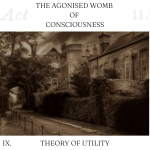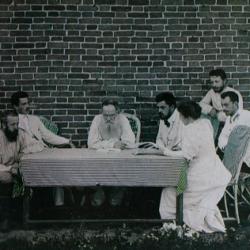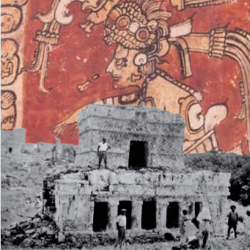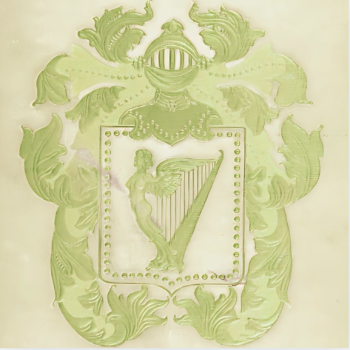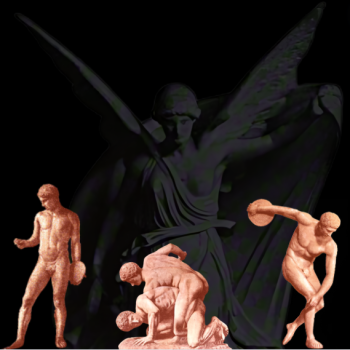ET IN ARCADIA EGO
ACT II.
VIII.
⸻
On October 19, 1888, the eve of departure, a second meeting was held in the rooms of the Royal Institute of British Architects. Colonel Olcott took the chair, and the rules for the newly formed British Section of the Theosophical Society were voted on.[1]

The Arcadia in 1887.[2]
The weather in Southampton was fair, if slightly foggy, when Charley, Verochka, Harte, and Baroness S.A, Krummesse boarded the S.S. Arcadia on October 20, 1888.[3] The steamer (and her three sister ships, Victoria, Britannia, and Oceana,) were built to celebrate the Jubilee Year (1887,) and was among the largest in the P. & O. Company’s fleet of fifty-four steamers. [4] It was a “veritable floating palace,” that boasted novel innovations, like electric lights, which made the long voyage more bearable for the 400 first-saloon, and second-saloon passengers en route to Bombay. The P &O Company “familiar as a household word to the traveler and sojourner in the East,” was among the institutions connected with Asia that formed part of British commercial supremacy. It earned a distinction in the half-century since its creation for performing an ever-increasing part in the maintenance of postal and passenger communication between England and India and China. [5]
There was no shortage of notable passengers on the trip. There was Sir Edward Watkin, M.P., the “King of the Railways,” and Elizabeth Adelaide Manning, writer, reformer, and well-known honorary secretary of the National Indian Association. She was going to India (at her own expense) for the aims of that organization. Three days before departure Manning was given a farewell party with W.W. Hunter and Syed Ameer Ali in attendance.[6] Of all the people who boarded, however, it was Mrs. Leach, an Irish woman, who sparked Verochka’s curiosity. Leach was traveling alone with her infant to be a tea-planter in Assam. The prospect of a better life where “the climate was heavenly, and the scenery glorious, the work fascinating, and the pay and prospects alluring,” was enough for her to leave her native land and take her chances in the hills of India.[7] Mrs. Leach, had a “short nose,” and “long upper lip and mouth,” according to Verochka, and resembled John Leech’s caricatures of the Irish in Punch magazine.[8]
Olcott left London two days later on board the Tidal Service Train for Naples. From there he would rendezvous with the delegate-Theosophists on the Arcadia for the last portion of the voyage to Bombay.[9]
~
Back in New York, on October 24, W.Q. Judge was speaking with a young Theosophist named Clement “Clem” Acton Griscom, Jr. in his office on Nassau Street.
The town of Brownsville, Texas, as stated in the secular and Spiritualist press alike, had been shelled with “mysterious bombardments.” The mariners (and the good people of Brownsville) alleged the cause of the spectral missiles was the vengeful spirits of drowned sailors.[10]
“Sailors are very superstitious,” said Clem. “Have you decided on which steamer you are taking to Europe?”
“The Umbria,” Judge replied.
“Ah, Captain McMickan,” said Clem. “He will not let the City of New York take the Blue Riband without a fight.”
The captain of the Umbria who celebrated his birthday with Andrew Carnegie during the last westward-bound voyage was proud man.[11] Ever since Clem’s father launched the Umbria’s rival, the S.S. New York, earlier that year, there was something of a rivalry in the press.[12] As McMickan told the Tribune weeks before, he “will not allow the City of New York to pass him between Sandy Hook and Queenstown if he and his engineers can help it.”[13]

(Left) 1885 University of Pennsylvania Football Team.[14] (Right) Clement “Clem” Acton Griscom, Jr.
Clem, a Quaker by birth, was an athletic twenty-year-old man whose family belonged to the “Philadelphia Aristocracy.”[15] Clem’s father, also named Clement, was the owner of the International Navigation Company, and had built a shipping empire with business connections to J.P. Morgan and P.A.B. Widener.[16] It was in the late autumn of 1884 that Clem first heard of Theosophy. “A big, blond College boy, playing center rush on the varsity football team,” he stood as high in his studies as he did in his sports. He was studying Berkeley’s Idealism, and John Stuart Mill’s theories on political economy at this time. One evening the conversation turned upon standards of conduct, and two of his friends entered a heated discussion on the “real aim of human life.” At first Clem was silent, but grew more and more intent as the talk progressed, “for a view of the meaning of life and of its possibilities was being presented such as he had never opened to him before.” His search for meaning continued, and he found a copy of Sinnett’s Esoteric Buddhism. He sat up all night reading it with “tense excitement.” He then bought every book and pamphlet on Theosophy that he could find, including Sinnett’s The Occult World (which had just been published,) and Blavatsky’s Isis Unveiled. He sent in his application for membership in The Theosophical Society and went to New York to see Judge.[17] He officially joined in March 1887, just about the time that Mohini Chatterji was lecturing in New York.[18] Clem, a recent graduate from the Wharton School, was preparing to take up a management position in the Red Star Line’s Chicago office. It was an exciting time for the young man, as he was also engaged to Genevieve Ludlow, an announcement he would make public the following month.[19]
After Clem left, Judge returned to Brooklyn. He promptly made his way to Brooklyn Hospital, where he placed Sattay in a paid ward. Walking the streets of Boerum Hill, Judge saw red bandanas in the crevices of muddy thoroughfare—the residue of the latest political “fad.”[20] A few nights earlier, Democrat supporters marched in procession by torchlight through the streets of Downtown Brooklyn, waving red bandanas, and chanting “Annie Laurie.”[21] The United States was nearing election day (November 6, 1888.) Republican Benjamin Harrison was running against Democrat incumbent, President Grover Cleveland. A “cult of personality” had developed around his running mate, Allen G. Thurman, who was known for waving a red bandana during speeches.[22] This emblem was “seized upon by the young and enthusiastic partisan,” as a sign of support for Democrats. “He is no true supporter of the Cleveland and Thurman cause,” it was said, “who does not flaunt a ‘red bandana.’”[23]

Brooklyn Hospital.[24]
Once inside the hospital, Judge sat for some time with his old friend. It was not an easy conversation.
“Will, I am ready to go away,” said Sattay. “I desire that I might be cremated, and my ashes thrown upon the river.”
With some difficulty, Sattay leaned upright in his bed in the Brooklyn Hospital, to affix his signature to the document:
I, Govinda Row Sattay, being of sound, and disposing mind and memory, do make, publish, and declare this my last will and testament in manner following:
First: I direct the payment of all my just debts and funeral expenses; and I request my executor to have my mortal remains reduced to ashes in the Long Island Crematory, and that no display occur at my funeral.
Second: I give, desire, and bequeath all my real, and personal property of whatsoever nature and wheresoever situated to my friend and fellow student, William Q. Judge. Counsellor of law of Willoughby Street, Brooklyn, to him, his heirs, and assign forever trusting to him to make such disposition of the same as he knows to be in accordance with my wishes.
Third: I make, constitute, and appoint William Q. Judge my sole executor of this last will and I request that better testamentary be granted to him without bonds. Witness my hand and seal, in the City of Brooklyn, this 24th day of October 1888. Kings County, New York. S. Govinda Row Sattay.[25]
“Will,” said Sattay, before slipping back into sleep, “If I die, all I have is for humanity. If I live. I will always work for it.”
Judge looked deeply upon his old friend and nodded. He then silently left the room. The brahmin’s health took a rapid turn for the worse after returning from Philadelphia, and Judge was not optimistic.
“He might linger for some time,” said the physician, “but he will not live.”[26]

Sattay’s Will.[27]
~
Prompted by his conversation with Commissioner Tucker a month earlier, Olcott decided to pay a visit to the castle of Count Mattei, the inventor of “Electro-Homeopathy,” to see whether it would be worthwhile for Tukaram to use in the Theosophical Bombay Charitable Dispensary.

Venturoli Mattei.[28]
Count Mattei’s adopted son, Signor Venturoli, escorted Olcott to Rioli, a small station on the road to Florence, high up in the Apennines, between Bologna and Pistola, where Mattei’s picturesque (but poorly-planned) castle, “Rochetta,” was located.[29]

Rochetta.[30]
Olcott met with Count Mattei in his private room in one of the turrets of Rochetta. Despite being eighty-four, Mattei was a strong, giant of a man. He was proud of the numberless cures wrought by his Electro-Homeopathy and was vehement in his denunciation of orthodox medicine.
Olcott heard far too many stories about Mattei’s cures to doubt their efficacy, but with regard to the “electrical” part of the matter, it was his belief that the true name for the system should be “sun-bathed” or “chromopathic” medicine.[31]

Count Mattei.[32]
Perhaps the Mattei pills and powders were just ordinary homeopathic remedies mixed together (as alleged by his opponents,) on the off chance that one of them will cure the patient. Maybe they were common remedies “exposed to chromopathic influence,” or “mesmerized to imbue them with a healing vital aura.” Of course, it did not matter a pin, thought Olcott, save as a trade secret, whether the efficacy of Mattei’s treatments stemmed from solar or herbal energy, the fact remained, his medicines cured thousands, and human suffering was diminished. At the end of the visit, Count Mattei kindly donated for a month’s supply of his electro-homeopathic remedies to the Bombay Charitable Dispensary for testing on 1,000 patients.[33]
Charley and the delegate-Theosophists on board the Arcadia, meanwhile, stopped in Marseille on October 26. Here “several eminent personages,” boarded the steamer, such as George Montgomerie, Lord Eglinton, Victor and Margaret Child-Villiers, the Count and Countess of Jersey, and Violet Greville, Lady Greville.[34]
Continuing his journey, Olcott to passed through Rome (where he stayed for a day.) He went to Saint Peter’s to lay his hand on the “heart of Christendom” and test her vibrations using psychometry (“soul measuring.”) Joseph Buchanan, who coined the term 1842, said that “psychometry means practically measuring by the soul, or grasping and estimating all things which are within the range of human intelligence.”[35] It was a technique that Judge had once described as “the power to bring up before the mental or spiritual eye a panoramic view of all that has occurred to the object examined.”[36]

The Nave of St. Peter’s, Rome, Italy. (c/o Digital Commonwealth)
Olcott’s experience at the Vatican was a curious one. He stayed there for hours, walking about without a guide, and asking no questions. As he looked around at the statues of kings, emperors, and popes, Olcott felt the karmic residue of the various “unholy alliances,” of the Catholic Church. He felt “horrors,” “injustice,” “selfish pacts,” “conspiracies to wrong and dominate the helpless victims,” “ruthless power,” and “self-delusion.”
“Rivers of blood set flowing in the name of God, but for the greed of tyrants!” thought Olcott. “Who, with an open mind, could stand in this monstrous cathedral and not shudder at the thought of what it represents in world-history!”[37]
On October 27, on board the train from Rome to Naples Olcott received a “most unexpected” and “splendid” visit from Master Morya. In his loving and compassionate way, Morya advised the President of the Theosophical Society. He told Olcott that he was pleased with the useful work he was doing, and his fervent desire to his duty. He also assured Olcott that despite all of his faults and shortcomings, he was by his side. Olcott felt so rejoiced, that he could “almost have jumped out of the window.”[38]

Colonel Olcott and Master Morya.[39]
The following day, when the Arcadia anchored in Naples, Olcott re-united with the delegate-Theosophists. As the Arcadia did not sail until 10 P.M., they had the chance to see from her deck the lovely panorama of the illuminated city mirrored in the glassy waters of the bay. A fairy scene.”

Harbor, Naples, Italy (c/o V&A Museum)
~
Back in Brooklyn, Sattay awoke to the sight of his friends, Theodocia Carpenter, and her husband, Benjamin.[40] He rubbed his eyes as though he were not entirely sure that he was awake, and then intoned their names with labored gasps.
“Water…please…” said Sattay.
“Nurse,” said Theodosia, “would you kindly bring some water to Mr. Sattay.”
Sattay contentedly sipped the water.
“I am just in life, and that is all. I am prepared for whatever might happen,” Sattay said faintly. His voice grew clearer with each sip of water. He was in good spirits. “Look round and see what a bright, cheerful room I am in. I am in the best of care. My cot is near a window, through which the shifting clouds are seen, and I am protected from draught by this white muslin screen.”
“Is there anything we can do?” asked Benjamin. He saw a record on the wall which indicated that Sattay was alarmingly worse.
“There is nothing left to do. I have made Mr. Judge my executor.”
There was a moment of silence at the implication of Sattay’s words.
“We brought you something,” said Theodocia. “Your favorite—dall and rice.”
“And some fruit,” chimed Benjamin.
“The doctor has me on a milk diet,” said Sattay. “Would you give these dainties to my friends.” Sattay pointed to the other two men in the ward.
Theodocia gave Sattay a newspaper which she brought for him to read.
“Would you leave it for the others? Where are the papers that should be in the hands of all these patients? I see boxes in all the railroad stations to receive them, but there are none here.”
“I don’t know,” Theodocia answered with shame. She remembered that she had never put any in.
Benjamin turned his back to set the basket of fruit on the table, by the time he turned around Sattay had fallen asleep. Benjamin spoke without noticing, and Sattay was roused.
“Ben,” whispered Theodocia, pressing a finger to her lips.
“Goodbye,” said Sattay, waving his hand as the Carpenters withdrew. “Goodbye.”[41]
Sattay passed away nine hours later, without a struggle. His illness was considered “obscure,” and an autopsy was held. The doctors ultimately decided that the cause of death was “malarial fever.”[42]

Amphitheatre of Hospital, 1888.[43]
Upon learning of Sattay’s passing, Judge raced to the hospital. He noticed Sattay’s upavita was missing.[44]
“Where is his Brahmanical cord,” Judge asked the doctors.
“The brambrambrical what now?”
“The sacred thread he wore around his chest,” Judge pressed. “Come now, what have you done with it?”
“I thought it was a bootlace,” laughed one doctor.
“I thought it was your stitching,” another doctor declared.
“Where is it?!”
“We burned it in the furnace, Mr. Judge.”[45]
It was with a heavy heart that Judge returned to his office. Later that morning he was paid a visit by Julia.
“Sattay has passed,” he said.
“I awoke from a sound sleep last night,” said Julia. “Feeling cold, I rose to close the window, and had hardly returned to my bed before a panoramic picture passed through the dark room. I saw a bed in a small hospital ward and noted all its special surroundings. On the bed Sattay lay dying; a nurse stood by him, and a subjective voice said, ‘This is Death.’ With that a second picture slid across the first, a dark and deserted dead room; in its center stood what looked like a table, yet I knew it was not one. Upon this lay a body prepared for burial and covered. The face I could not see but saw through the covering the position of the hands and knew it to be Sattay. The pictures passed like vivid flashes. ‘Sattay is dead!’ I yelled. Lighting a match, I looked at my watch. It was half past eleven. He died that night at half past twelve. So she saw at once what was transpiring at the hour of her vision, and also the future event.”
She accurately described all the surroundings of the hospital, despite never having been there. The details, and position of the dead.[46]
~
Sattay was cremated at Fresh Pond crematory, Long Island, on the afternoon of Tuesday, October 30, 1888.[47] Just a short distance from the Sampson Brothers oil cloth factory, on a large hill opposite Mt. Olivet Cemetery, stood the simple, one story, Romanesque structure, made of brick and the repurposed marble of the old St. Nicholas Hotel.[48]

Fresh Pond Crematory (as it would have looked in 1888.)[49]
There were those who thought the practice of cremation to be incompatible with a belief in the resurrection. In 1874, the Lord Bishop of Lincoln, told a vast congregation in Westminster Abbey that the “practice incineration” was “barbarous and unnatural.” He added that one of its very first results would be “the undermining of the faith of mankind in the doctrine of the resurrection of the body.” Cremation societies were so numerous now, that the public no longer regarded them as sensational, and since Fresh Pond Crematory opened on December 4, 1885, just over 200 bodies had been consigned to her flames (half of them once belonging to Germans, who favored the process over burial.)[50] Though Sattay was only the second Theosophist to be cremated in America, he was the first Indian (South Asian,) and Hindu (of any caste,) to undergo the process in the West.[51]
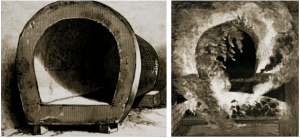
(Left) The Incinerator (Right) The Position of the Incinerator in the Furnace.[52]
The building inside was divided into two rooms. The iron doors of the retort room opened into a reception room, where rows of seats were placed in front of the oven and the process could be witnessed by friends, and where services could be held. In a niche in the wall of this room there was a glass urn that contained the ashes of a ram incinerated as an experiment in the retort.
At one end there were furnaces, over which there were two ovens, twenty feet long, four feet wide, and three feet high. From each oven (which were heated to 2,150 °F before the body was placed in) there were two tubes leading to the roof, where they were met by other tubes containing steam, and as the gas from the ovens were emitted from the tubes, it was met by the steam, and “every vestige of life” was destroyed before being released in the air. (When the crematory first began operations, “people residing near it complained of the odor which proceeded while the incinerations were in progress.”)[53] The fire of cremation were started twelve hours before the ovens were used and took 1,700 pounds of coal to heat it for one body.
“Sanitary science,” of the West, espoused by Professor Justus von Liebig (and adopted by chemists and physicians) now understood decomposition as nothing more that “oxidation,” or “a solitary or desolate burning.” Since everyone burned away eventually, it only made sense that the progressive West would minimize the agency of Nature and mechanize the process.
Had Sattay died in India, his cremation would have been decidedly different. In the absence of his eldest legal heir, the one closest to him would have applied fire to his head. Being a Brahmin, his corpse might have been cremated by pupils (if he had them) by the Acharya (spiritual teacher) who made him twice born, whispering mantras known as gayatris in his ear. Sattay’s cremator would have taken a ritual bath, put on new clothes, and boiled rice. He then would have bathed Sattay’s corpse, dressed it in new clothes, and placed it on the ground overspread with kusha (a type of grass ritually significant in some Vedic rituals) with the head toward the south. After this the body was “besmeared” with ghee (a clarified butter sometimes used in religious rituals.) A ring made of kusha would then be placed on the hand of the corpse, and the cremator would chant the following mantra: “I bathe thee with the sacred water of Gya, Kurukshetra, Pindarak, and other places of pilgrimage; of the sea; of the Ganges, the Jumna, the Koushikee, the Suraya, the Chandrabhaga, and other rivers that rise from the mountains.” After the recitation, the lifeless body was washed a second time. New clothes, and a new upavita (sacred thread would be put on the body. Sattay’s body would then be “besmeared with powdered sandalwood,” and the ears, nostrils, eyes, and mouth would each be made a receptacle of seven different pieces of gold (or, for lack of gold, seven pieces of bell metal.) The body was then placed on the funeral pyre (a portion of which being sanctified to with a wash of cow dung) with the head to the south. The cremator, ritually cleansed, and seated on the ground overspread with kusha, would then perform the preparatory rite of Achaman (water purification rite) with his face turned towards the east, then turning towards the south and bending the right knee and putting the uttariya (garment similar to a shawl) on his right shoulder. Having recited the proper series of mantras, the cremator would have circled his body three times with a blazing fire in his hand which, in the end, would be placed on the head of the departed Sattay. When the cremation was almost finished, the cremator would have placed seven small pieces of wood and thrown each of them in succession on the funeral When this was done, the fire would have been put out with water. A large kalsi (earthen vessel) full of water, along with a sara (earthen plate) containing seven kowries (shells,) would then be placed on the extinguished pyre. The cremator would the say the mantra: “O Thou flesh-consuming Fire! I pay respect to thee.” Using an axe to strike the remaining, unburnt, pieces of the wood of the funeral pyre, the funeral party would accompany the cremator to a river where every one of them would submerge in the ceremony of the turpan. The Sattay’s bones would have been buried in the bed of the Ganges (or other river held sacred by Hindus.)[54]

Placing the Body in the Incinerator.[55]
But Sattay was in New York. The rituals were different. Judge paid a $35 fee at the office of United States Cremation Company.[56] Sattay’s body was brought into the crematory in a coffin, where it was and placed onto a table with wheels under its four legs. The surface of this table were set rollers which spun at the touch. Judge gazed upon the face of his friend and motioned for the attendant that he was ready. A shallow-ribbed Norway iron crib, suspended from the ceiling, was lowered to the floor. It resembled the lower portion of a coffin, cut in two through its side diameter. Two strips of muslin (which resembled a bed sheet cut in two length-wise) were saturated in a barrel of alum water and spread over the crib. Sattay’s body was lifted from the coffin and placed in the crib and wrapped in its own alum-water-soaked muslin. (This was done to prevent his clothing from igniting when first put in.) Though Sattay only wanted a simple service, Judge did his best to solemnize the occasion. While the body was being wrapped, Judge read the Vedic funerary hymnal given to the Theosophists in 1878 by the Arya Samaj:
May the light of thy mind, glorify thee and thy body. Oh, blessed and God, bless this being, and take him to the regions of the blessed. Oh being, may thy body, created by the grace of God, be happy and beneficent. The funeral fire is Kravyada. We walk that fire to the distance. May it reach the regions of the wind midway between heaven and earth. That fire is rapid in light. May it take thee quickly to the blessed regions. May other sacrificial fires and the grace of God ever shine in our midst and bless the learned. Oh, being, do thou depart to the blessed regions. Do thou enjoy perpetual air, the firmament, the blessed body, the equally blessed knowledge, and communion with God; and having enjoyed long life and the comforts thereof, do thou again thyself from the body and enter another blessed life.[57]
The crib was hoisted up and placed on the wheeled-table and taken to a spot twenty feet in front of the furnace. Two stout attendants wheeled the table into position in front of the door of the retort, which was opened with two heavy weights. The attendants unscrewed the iron nuts, and the door opened. The fervent heat of the furnace glowed a rosy-red, that, like all things of transcendent beauty and awful grandeur, producing a humbling peace in the beholder. There were no billowy flames. There was no crackling sound. The door was left open just long enough for the two attendants to seize the long iron rods with wooden handles that allowed them to thrust the crib into the heated chamber. The door was lowered and closed with a clang. The attendants screwed the iron nuts back on and tightened the bolts. A glimpse of the interior could be had through the glass “bull’s eye” set in the iron door. The radiance of the flame grew dim and pale. The “bulls-eye” was clouded by the gasses arising from the body and remained so until the incineration was complete two hours later. The oven was left to cool, and the ashes, about three quarts, were dropped into the chamber below and drawn into an urn.[58]

An Urn.[59]
← →
THE AGONIZED WOMB OF CONSCIOUSNESS SECTIONS: “ACT II”
I. THE LITTLE TOY TEMPLE ON NASSAU STREET.
II. UNION OF HEARTS.
III. IN DARKEST LONDON.
IV. NONSENSE OF BROKEN TEACUPS.
V. A CURIOUS REUNION ON WALNUT STREET.
VI. GLORIFIED IN THE LAND OF BABYLON.
VII. ALWAYS THIN AND GRAVE.
VIII. ET IN ARCADIA EGO.
IX. THEORY OF UTILITY.
X. APOLLO BUNDER.
XII. THE SILENT PASSENGER.
XIII. DECCAN PLATEAU.
SOURCES:
[1] “Theosophical Activities.” Lucifer. Vol. III, No. 14 (November 15, 1888): 260-263.
[2] “SS Arcadia.” Graces Guide To British Industrial History. Accessed August 31, 2021. https://www.gracesguide.co.uk/SS_Arcadia.
[3] “Per P. & O. Co.’s Steamer ‘Arcadia.’” The Colonies And India. (London, England) October 17, 1888; “London Weather Forecast This Day.” The London Evening Standard. (London, England.) October 20, 1888.
[4] Child-Villiers, Margaret Elizabeth Leigh. Fifty-One Years Of Victorian Life. John Murray. London, England. (1922): 146; “The President’s Tour.” Supplement To The Theosophist. (December 1888): xxvi-xxvii.
[5] Boulger, Demetrius. “The P & O. Company.” The Asiatic Quarterly Review. (April 1889): 241-258.
[6] “Miss E.A. Manning.” The Homeward Mail from India, China, and the East. (London, England) October 22, 1888; “Steamer Movements.” The Times Of India. (Bombay, India) November 12, 1888; Manning, E. A. “My Tour In India.” The Indian Magazine. No. 221. (May 1889): 219-224.
[7] Cox, Edmund C. My Thirty Years In India. Mills & Boon. Limited. London, England. (1909): 2.
[8] In Vera Johnston’s article, “Home From India,” she mentions that on the return voyage from India, her special sympathy was aroused by the tree planter from Assam who was traveling with three small children. “We recognized her as an old acquaintance. When we went to India for the first time, she was also our companion.” The article further states that this woman now had an additional child since their first arrival. (a.) The only person who seemingly fits this description is one Mrs. Leach, who arrived in India on the Arcadia with an infant and left on the Siam (the same steamer as Charley and Vera) with a child and an infant. (b.) There is a discrepancy by one in the number of children listed in Vera’s article, but this might be creative license on Vera’s part. [(a.) Johnston, Vera. “Home From India.” Russian Review. (May 1891): 245-278; (b.) “Shipping Intelligence.” The Madras Weekly Mail. (Madras, India) July 2, 1890; “Port Of Calcutta.” Englishman’s Overland Mail. (London, England.) November 20, 1888. [Sketches For Cartoons In Punch Magazine Including ‘A Good Day For Ireland’, 1860s. Royal Academy. https://www.royalacademy.org.uk/art-artists/work-of-art/sketch-for-a-i-punch-i-cartoon-entitled-a-great-time-for-ireland.]
[9] “The President’s Tour.” Supplement To The Theosophist. Vol. X (December 1888): xxvi-xxviii.
[10] “Marine Ghosts.” The Brooklyn Daily Eagle. (Brooklyn, New York) October 24, 1888.
[11] “A Veteran Commander’s Birthday.” The Times-Democrat. (New Orleans, Louisiana) October 21, 1888.
[12] “Launch Of An Inman Steamer.” The Liverpool Mercury. (Liverpool, Merseyside, England) March 16, 1888.
[13] “Oh, No! They Wouldn’t Race.” The New York Tribune. (New York, New York) August 18, 1888.
[14] Gutowski, N. (2006, April). Penn Football: Origins to 1901 (Penn Football: 1885 Team.) University Archives and Records Center. https://archives.upenn.edu/exhibits/penn-history/football/teams/team-1885.
[15] Burt, Nathaniel. The Perennial Philadelphians: The Anatomy of an American Aristocracy. University of Pennsylvania Press. Philadelphia, Pennsylvania. (1999): 448.
[16] Carosso, Vincent P. The Morgans: Private International Bankers, 1854-1913. Harvard University Press. Cambridge, Massachusetts. (1987): 246-249.
[17] Mitchell, Henry Bedinger. “A Stone of the Foundation.” The Theosophical Quarterly. Vol. XVII, No. 1 (July 1919): 9-21.
[18] Theosophical Society General Membership Register, 1875-1942 at http://tsmembers.org/. See book 1, entry 3924. (website file: 1B:1885-1890) Clement Acton Griscom, Jr. (3/22/1887.)
[19] “Hail! Wedded Love: A Long List of Marriages and Engagements in Philadelphia.” The New York Herald. (New York, New York) November 18, 1888; “Bride Is Niece Of Hancock.” The Boston Globe. (Boston, Massachusetts) September 19, 1889; “Wired From The City.” The Boston Herald. (Boston, Massachusetts) September 19, 1889.
[20] Vance, L.J. “Literary ‘Fads.’ The Epoch. Vol. IV, No. 83 (September 7, 1888) 80.
[21] “Solid Ranks.” The Brooklyn Daily Eagle. (Brooklyn, New York) October 13, 1888.
[22] Poore, Benjamin Perley. Perley’s Reminiscences of Sixty Years in the National Metropolis: Vol. II. Hubbard Brothers. Philadelphia, Pennsylvania. (1886): 359-360.
[23] “Allen G. Thurman.” The Phrenological Journal. Vol. LXXXVIII, No. 2 (August 1888): 82-84.
[24] Brooklyn: Brooklyn Hospital, undated. Geo. P. Hall & Son. George P. Hall & Son photograph collection, ca. 1876-1914. Series II: The Bronx, Brooklyn, Queens, and Staten Island. New York Historical Society.
[25] Wills And Indexes, 1787-1923; Author: New York. Surrogate’s Court (Kings County); Probate Place: Kings, New York.
[26] Keightley, Julia. “Tea Table Talk.” The Path. Vol. III, No. 9. (December 1888): 293-297.
[27] Wills And Indexes, 1787-1923; Author: New York. Surrogate’s Court (Kings County); Probate Place: Kings, New York.
[28] “Can Cancer Be Cured?” The Review of Reviews. Vol. III, No. 13. (January 1891): 34-51.
[29] Paget, Wally. “A Visit To Count Mattei.” The National Review. Vol. XV, No. 86. (May 1890): 347-355.
[30] “Can Cancer Be Cured?” The Review of Reviews. Vol. III, No. 13. (January 1891): 34-51.
[31] Olcott writes: “I may be wrong, but from all I can hear and infer from the behavior of the medicines, I am persuaded that the words ‘blue electricity,’ or green, yellow, red, or others, mean simply distilled water which has been exposed to the magical action of the sunlight, passed through panes or lenses of glass of those several colors : that in the Mattei system we are dealing, in reality, with Chromopathy.”
[32] “Can Cancer Be Cured?” The Review of Reviews. Vol. III, No. 13. (January 1891): 34-51.
[33] “The President’s Tour.” Supplement To The Theosophist. Vol. X (October 1888): xvii-xviii; Olcott, H.S. “Old Diary Leaves: Fourth Series, Chapter IV.” The Theosophist. Vol. XXI, No. 6. (February 1900): 257-265.
[34] “Departure Of Passengers.” Homeward Mail From India, China And The East. (London, England) September 28, 1888.
[35] Buchanan, Joseph Rodes. Manual of Psychometry. Joseph Rodes Buchanan. Boston, Massachusetts. (1885): 3-4.
[36] Judge, William Quan. “Psychometry.” The Platonist Vol. II, No. 1. (January 1884): 5-6.
[37] Olcott, H.S. “Old Diary Leaves: Fourth Series, Chapter IV.” The Theosophist. Vol. XXI, No. 6. (February 1900): 257-265.
[38] Murphet, Howard. Hammer On The Mountain. The Theosophical Publishing House. Wheaton, Illinois. (1972): 235-236.
[39] Based on a 1901 illustration found in: Olcott, Henry Steel. “My Experiences With Mahatmas.” The San Francisco Call. (San Francisco, California) March 24, 1901.
[40] Tenth Census of the United States, 1880. (NARA microfilm publication T9, 1,454 rolls). Records of the Bureau of the Census, Record Group 29. National Archives, Washington, D.C. Year: 1880; Census Place: Union, Union, New Jersey; Roll: 801; Page: 343B; Enumeration District: 178.
[41] Dall, Caroline Healey. “A Hindoo Theosophist.” The Unitarian Review. Vol. XXXI, No. 5 (May 1889): 397-410.
[42] New York, Kings County, Probate Records; Author: New York. Supreme Court (Kings County); Probate Place: Kings, New York; Dall, Caroline Healey. “A Hindoo Theosophist.” The Unitarian Review. Vol. XXXI, No. 5 (May 1889): 397-410.
[43] “Instruction in Surgery.” Frank Leslie’s Illustrated Newspaper. Vol. LXVI, No. 1,702 (April 28, 1888): 168.
[44] Hastings, James (ed.) Encyclopedia of Religion and Ethics: Vol. II. Charles Scribner’s Sons. New York, New York. (1910): 407.
[45] “Ashes Not Scattered.” The New York Times. (New York, New York) December 31, 1888.
[46] Keightley, Julia. “Tea Table Talk.” The Path. Vol. III, No. 9. (December 1888): 293-297.
[47] “Notes.” The Chicago Tribune. (Chicago, Illinois.) November 2, 1888.
[48] “The Long Island Crematory.” Frank Leslie’s Illustrated Newspaper. Vol. LXL, No. 1,571 (October 31, 1885): 166-167; “Maspeth.” The Times Union. (Brooklyn, New York) December 11, 1888.
[49] “A Sign of the Times?” The Morning Call. (Paterson, New Jersey) August 9, 1888.
[50] “A Sign of the Times?” The Morning Call. (Paterson, New Jersey) August 9, 1888.
[51] “Strange Rites.” The Cincinnati Post. (Cincinnati, Ohio) March 19, 1894.
[52] “The Long Island Crematory At Fresh Pond.” Frank Leslie’s Illustrated Newspaper. Vol. LXL, No. 1,571 (October 31, 1885): 168.
[53] “Maspeth.” The Times Union. (Brooklyn, New York) December 11, 1888.
[54] Bisvas, Nakur Chandra. “The Rites of Cremation Among the Hindus.” The Theosophist. Vol. XII, No. 3. (December 1890): 137-140.
[55] “The Long Island Crematory At Fresh Pond.” Frank Leslie’s Illustrated Newspaper. Vol. LXL, No. 1,571 (October 31, 1885): 168.
[56] “Current Topics.” The Rochester Democrat and Chronicle. (Rochester, New York) October 11, 1888.
[57] Curtis, David A. “Baron De Palm’s Ashes.” The Sun. (New York, New York) October 20, 1878; Curtis, David A. “The Last of Baron De Palm.” The Sun. (New York, New York) November 21, 1878.
[58] H.M.V. “Incineration.” The Chironian. Vol. IV, No. 6 (January 16, 1888): 85-86; “In A Crematory.” The Alma Record. (Alma, Record) February 10, 1888.
[59] “The Long Island Crematory At Fresh Pond.” Frank Leslie’s Illustrated Newspaper. Vol. LXL, No. 1,571 (October 31, 1885): 168.



